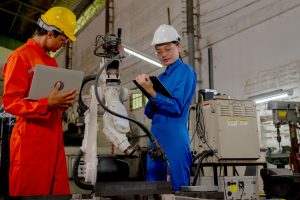In today’s fast-changing world of technology, polyfunctional robots—amazing machines built to tackle various tasks—are becoming essential across many industries! Unlike traditional robots, which usually stick to just one job, these adaptable machines can easily shift between different roles, boosting efficiency and delivering a great return on investment. Designed to handle multiple functions, polyfunctional robots can seamlessly transition from one task to another as needed. This flexibility turns them into truly valuable partners in lively environments where operational needs can change quickly.
The versatility of polyfunctional robots enables their deployment in various sectors:
- Healthcare: In medical settings, these robots assist in surgeries, patient care, and administrative tasks, improving service delivery and patient outcomes.
- Manufacturing: Polyfunctional robots handle tasks ranging from assembly to quality control on production lines, enhancing efficiency and reducing labor costs.
- Logistics: In warehouses, these robots manage inventory, package goods, and facilitate shipping processes, streamlining operations and reducing errors.
- Agriculture: Polyfunctional robots assist in planting, harvesting, and monitoring crop health, contributing to increased agricultural productivity.
Several technological innovations propel the development of polyfunctional robots:
- Artificial Intelligence (AI) and Machine Learning: These technologies enable robots to learn from data, adapt to new tasks, and make informed decisions, enhancing their functionality.
- Advanced Sensors: Equipped with sophisticated sensors, polyfunctional robots can perceive their environment highly, allowing for better interaction and task execution.
- Modular Design: Many polyfunctional robots feature modular components that can be reconfigured for different tasks, increasing their adaptability and utility.
The adoption of polyfunctional robots offers several advantages:
- Increased Productivity: These robots significantly boost operational output by performing multiple tasks without the need for breaks.
- Cost Efficiency: Investing in a single polyfunctional robot can be more economical than purchasing multiple single-function machines, leading to cost savings.
- Flexibility: The ability to switch between tasks allows businesses to respond swiftly to changing demands and operational requirements
Despite their advantages, the implementation of polyfunctional robots comes with challenges:
- Complexity: Designing and programming robots capable of multiple functions can be technically challenging and may require substantial expertise.
- Integration: Seamlessly integrating these robots into existing workflows necessitates careful planning and may involve restructuring current processes.
- Cost: The initial investment for advanced polyfunctional robots can be significant, potentially posing a barrier for smaller enterprises.
As technology advances, the capabilities of polyfunctional robots are expected to expand further. Emerging trends include developing self-reconfiguring modular robots that can alter their physical form to suit different tasks, enhancing their versatility. Moreover, ongoing AI and machine learning improvements will likely endow these robots with even greater autonomy and decision-making abilities, reducing the need for human intervention and supervision.
Polyfunctional robots represent a significant leap forward in automation technology. Their ability to perform multiple tasks across various industries enhances efficiency and productivity and offers a flexible solution adaptable to the evolving demands of the modern world.
For a visual overview of how polyfunctional robots are transforming modern life, you might find this video insightful:



